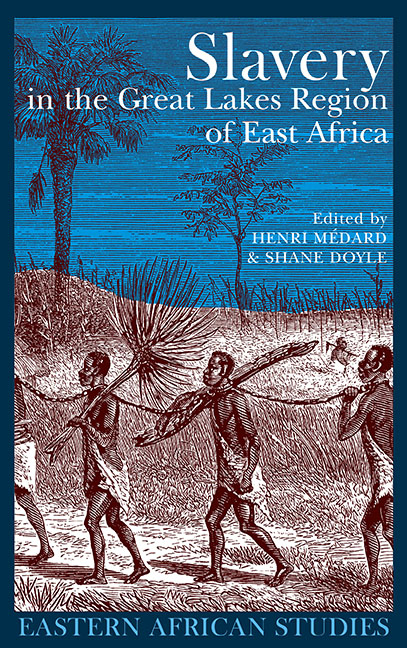Book contents
- Frontmatter
- Dedication
- Contents
- List of Maps & Tables
- Notes on Contributors
- Introduction
- 1 Violence, Marginality, Scorn & Honour: Language evidence of slavery to the eighteenth century
- 2 Notes on the Rise of Slavery & Social Change in Unyamwezi c. 1860 –1900
- 3 Slavery & Forced Labour in the Eastern Congo 1850 –1910
- 4 Legacies of Slavery in North West Uganda: The story of the ‘One-Elevens’
- 5 Human Booty in Buganda: Some observations on the seizure of people in war c.1700 –1890
- 6 Stolen People & Autonomous Chiefs in Nineteenth-Century Buganda: The social consequences of non-free followers
- 7 Women's Experiences of Enslavement & Slavery in Late Nineteenth- & Early Twentieth-Century Uganda
- 8 Slavery & Other Forms of Social Oppression in Ankole 1890 –1940
- 9 The Slave Trade in Burundi & Rwanda at the Beginning of German Colonisation 1890 –1906
- 10 Bunyoro & the Demography of Slavery Debate: Fertility, kinship & assimilation
- References
- Index
10 - Bunyoro & the Demography of Slavery Debate: Fertility, kinship & assimilation
Published online by Cambridge University Press: 11 August 2017
- Frontmatter
- Dedication
- Contents
- List of Maps & Tables
- Notes on Contributors
- Introduction
- 1 Violence, Marginality, Scorn & Honour: Language evidence of slavery to the eighteenth century
- 2 Notes on the Rise of Slavery & Social Change in Unyamwezi c. 1860 –1900
- 3 Slavery & Forced Labour in the Eastern Congo 1850 –1910
- 4 Legacies of Slavery in North West Uganda: The story of the ‘One-Elevens’
- 5 Human Booty in Buganda: Some observations on the seizure of people in war c.1700 –1890
- 6 Stolen People & Autonomous Chiefs in Nineteenth-Century Buganda: The social consequences of non-free followers
- 7 Women's Experiences of Enslavement & Slavery in Late Nineteenth- & Early Twentieth-Century Uganda
- 8 Slavery & Other Forms of Social Oppression in Ankole 1890 –1940
- 9 The Slave Trade in Burundi & Rwanda at the Beginning of German Colonisation 1890 –1906
- 10 Bunyoro & the Demography of Slavery Debate: Fertility, kinship & assimilation
- References
- Index
Summary
Introduction
Bunyoro is one of the oldest kingdoms in East Africa. It is reputed to have been the most powerful state in the interlacustrine region many centuries ago, but its strength dissipated in the first half of the nineteenth century and, after a brief resurgence in the 1870s and 1880s, it became one of the poorest and least significant parts of Uganda (see Map 4). At the heart of this story is a process of dramatic demographic change that saw Bunyoro decline from being one of the most densely populated states in East Africa to becoming the district with the second lowest population density in colonial Uganda. Bunyoro's demographic problems developed in the nineteenth century and appear to have provided the primary stimulus for the kingdom's rapidly increasing involvement in raiding and trading for slaves. As a number of chapters in this volume have illustrated, demography lies at the heart of slavery, which typically relies on forced migration, interferes with the marriage market and reduces life expectancy. In Africa the development of slavery should perhaps always be viewed, in part at least, as a function of the continent's low population density and consequent competitive struggle for followers and labour. In a society where childlessness was becoming epidemic, the forceful acquisition of wives and workers took on a new significance
What is ironic about Bunyoro's history, however, is that its very success in adapting rapidly to the new long-distance commerce of the late nineteenth century ultimately resulted in demographic disaster. Bunyoro became a powerful middleman in the commercial networks of the interlacustrine region, mastering the art of warfare with firearms, and profitin hugely from the exchange of coastal imports for northern Uganda's ivory and slaves. Bunyoro's new strength, its resistance to Egyptian imperialism, its aggressive territorial expansion and support for the Muslim faction in Buganda's civil wars, all tended to identify it as an opponent of Western civilisation and legitimate commerce.
- Type
- Chapter
- Information
- Slavery in the Great Lakes Region of East Africa , pp. 231 - 251Publisher: Boydell & BrewerPrint publication year: 2007

